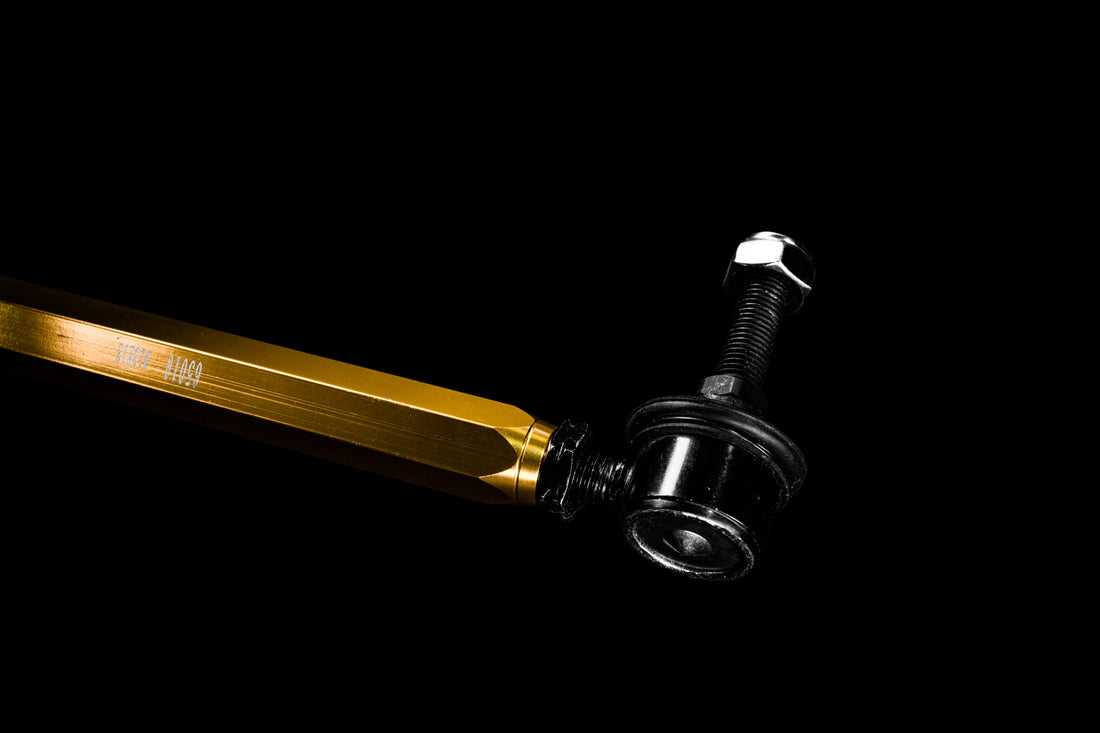Are uprated and adjustable anti-roll bar drop links necessary? Here we discuss why they could be the next essential bit you need for your anti-roll bars.
As you are probably aware, connected to the end of most sway bars is a drop link. It is the job of the drop link to transfer the roll stiffness generated by the bar. By and large a drop link is used to connect the end of the anti-roll bar to the damper or a control arm. In most instances the drop link is used to ensure that the load is orientated correctly, and to bridge the gap between the anti-roll bar and the connection. This can often be quite large and drop links of up to 300 mm are not uncommon.

However not all anti-roll bars are connected by drop links. For example, looking at front wheel drive rear suspension for a moment, a number of torsion bar suspension designs have an anti-roll bar that runs through the central beam, and is then connected to the trailing arm via a solid metal connection. Separate torsion bars then control the spring rate. Some other designs connect the bar rigidly to an axle.
This may sometimes seem odd as if the anti-roll bar is bolted solidly to the axle why not just increase the rigidity of the axle? Some cars have done away entirely with the rear anti-roll bar and engineered the roll stiffness into the axle beam. The downside being that it then lacks subtlety in response and it’s a hard thing to get right. This is why most semi-independent trailing arm suspensions still run a separate anti-roll bar.
On some front wheel drive applications, Whiteline may specify an additional anti-roll bar mounted on the axle beam and added in tandem with the existing bar. This is usually the case, on a semi-independent torsion beam suspension such as a VAG group applications with a rear beam axle. These bars are always connected by a separate anti-roll bar drop link.

Whiteline are well known for producing adjustable anti-roll bars and these have a number of holes formed in the end of the bar which enable the drop link to be unbolted and then moved. This changes the lever length of the anti-roll bar. If the lever is shortened then the roll stiffness increases, conversely if the lever is lengthened, the roll stiffness decreases.
When purchased in kit form, heavy duty adjustable drop links are often included making it a complete package, however many anti-roll bars sold do not come with drop links, and you are expected to use the original equipment link on the car. Most of the time these links are adequate. Certainly they are from the original equipment manufacturer.
Unfortunately in the aftermarket there are often cheaper alternatives which don’t last as long. If you take a design that is weaker than the original and then put higher loads through it, you can definitely expect lost rate and there’s a very good chance it might break. There is also the likelihood to wear the bearing more quickly and cause knocking if it doesn’t break it.

It is useful to consider the loads we’re dealing with. Lets imagine a 3 foot wide bar with 6 inch levers. If this was 1 inch in diameter it would create 834 lbs roll stiffness for each inch of movement. What happens if we move the lever point just 1 inch? Making it 1 inch longer brings the stiffness down to 605 lbs / in and shortening it by 1 inch increases it to a mighty 1218 lb/in.
If we imagine that the original bar was just ¾ inch thick and had a fixed 6 inch lever it would have given us just 264 lbs of roll stiffness. So it’s easy to see that by running a larger diameter anti-roll bar and running it in the stiffest position, the drop link has to cope with massively increased loads.

Another factor with drop links connected to adjustable anti-roll is that as the bar is adjusted the angle of the drop link will change. This means that the load will no longer be solely in the intended orientation (which would be North – South as you looked at a link). Instead the drop link would now be receiving loads at an angle which will put the ball joint under more stress.
The solution to this is simple as Whiteline supplies a range of adjustable drop links. This means you can get the link adjusted to the correct length, to ensure the loads are received in the correct plane.

There is another benefit of having adjustable anti-roll bar drop links, and that is their use in the practice of corner weighting. When you corner weight a chassis it is important to disconnect the anti-roll bars, due to their impact on the weight distribution of the vehicle when it is adjusted statically. Then when the vehicle has been corner weighted the anti-roll bars should be reconnected.
However, if you try doing this with an original equipment link, which will usually not be adjustable, you will be connecting the anti-roll bars to the links with pre-load. This will then skew the corner weights that you so painstakingly set earlier.

So there you have it, adjustable drop links that are uprated are not just for show. They enable you to set the length of the link to ensure the load is carried correctly, and set the length of the link to ensure there is no preload. In short they are an essential part of anti-roll bar performance and worth seeking out where adjustable, uprated versions are available.


